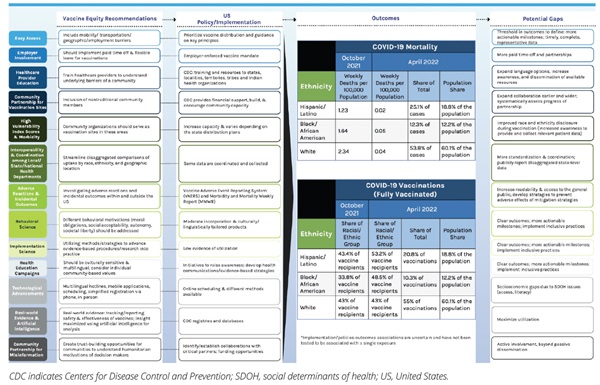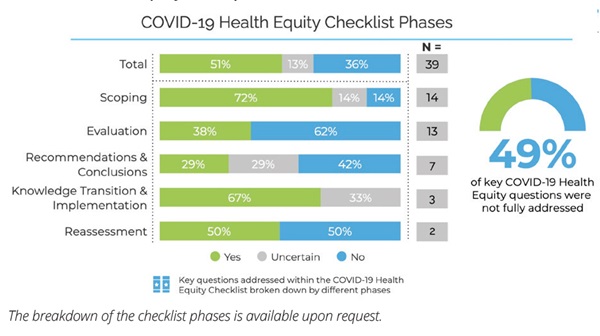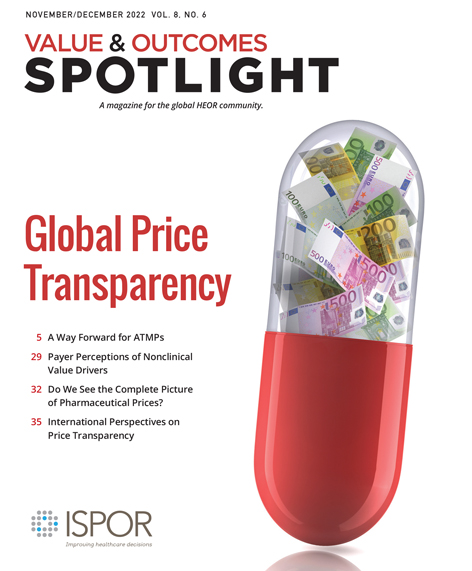Equitable Access to COVID-19 Vaccines in the United States: An Overview of the Evidence-Based Recommendations and Evaluation of the Outcomes
Yejin Lydia Lee, PharmD, Kelly Zhou, BS, Rutgers Ernest Mario School of Pharmacy, Piscataway, NJ, USA; Kelsey Lee, PharmD, Bayer Pharmaceuticals, Whippany, NJ, USA; Hyebina Park, PharmD, Merck & Co, Kenilworth, NJ, USA; Mark Neese, PharmD, MS, Bayer Pharmaceuticals, Whippany, NJ, USA; Zeba M. Khan, RPh, PhD, Rutgers Ernest Mario School of Pharmacy and Center for Health Outcomes, Policy & Economics, Piscataway, NJ, USA
Introduction
Despite demonstrated positive risk-benefit ratio of COVID-19 vaccines and availability at an unprecedented speed, vaccination rates vary in the United States. Areas with low vaccination rates may increase the risk of severe infections and viral mutations that threaten our progress in preventing the spread of COVID-19. This uneven vaccine distribution has been partly due to health inequity.1,2
Health inequity consists of systematic differences in marginalized, disadvantaged populations with vulnerabilities in various social determinants of health (SDOH). SDOH are defined as the environmental conditions in the places people inhabit, which impact a wide range of health risks and outcomes. Due to SDOH that exacerbate comorbidities, minority populations have a 5 times greater risk of adverse COVID-19 consequences. Thus, equitable COVID-19 vaccine access has been proposed to mitigate the disproportionate effect of the COVID-19 pandemic in underserved populations often predisposed to health inequity.2
Equitable access is more than equal access. Health equity allows all individuals to have the chance to achieve optimal health according to their individual needs. During the COVID-19 pandemic, it has become clear that to achieve health equity in vaccination rates, individualized accessibility solutions addressing SDOH are essential. However, there is only a limited amount of clear, evidence-based, and validated guidance on improving health equity. The objective of this paper is to foster future pandemic preparedness and prevent further delays in health equity by reviewing the recommendation and efforts toward vaccine equity evident during the COVID-19 pandemic.
To achieve this, some of the evidence-based recommendations for vaccine equity, policy, and implementation strategy will be reviewed. Then the outcomes of the implementation strategy will be evaluated using the equity checklist for Health Technology Assessment (ECHTA) adapted for qualitative analysis.2,3
Recommendations for Vaccine Equity in Policy and Implementation
Public health policy and implementation should utilize multifaceted, evidence-based approaches. Figure 1 lists some high-level recommendations that serve as a nonalgorithmic checklist to encourage a nonbiased, individualized, and collaborative approach to prevent any inadvertent exacerbation of health inequity.
Figure 1. Vaccine equity recommendations, US policy/implementation, and potential gaps*1-7

First and foremost, vaccinations should be easily accessible for all, including those with mobility, transportation, geographic, or employment barriers. This may entail vans delivering vaccines, vaccination sites near public transportation hubs, employer-affiliated delivery programs, and operations beyond standard business hours. Employers should implement policies such as paid time off and flexible leave for vaccinations.1,2
As access is established, community partnerships are integral to health equity developments. Inclusion of nontraditional community members such as individuals most affected or familiar with the community would challenge and broaden the perspectives of the decision makers. One of these participations may include involvement in healthcare provider training to help understand the community’s vulnerabilities, identities, experiences, and underlying barriers. Community organizations may also serve as vaccination sites, especially in areas with high vulnerability index scores and morbidity. Consequently, these collaborations lead to trust-building opportunities for the communities to understand the humanitarian motivations of the decision makers.1,2
In order to fortify such trusted relationships, the community should be involved in the development and dissemination of relevant health education to gain public support and overcome vaccine hesitancy. Such campaigns should be culturally sensitive and multilingual while considering individual community-based value elements, lived experiences, political stances, scientific understanding, and perceived motives of healthcare industries. Transparency in health education should be further amplified through investigating adverse reactions and incidental outcomes within and outside the United States.1,2
Minority populations have a 5 times greater risk of adverse COVID-19 consequences. Asian (59%) and White (54%) received the highest shares of booster doses, while less than half of Black (44%) and Hispanic (40%) received booster doses.
Likewise, these efforts may benefit from appropriately utilizing technological advancements. This may be achieved through multilingual hotlines, mobile applications for addressing vaccine-related concerns and scheduling, and simplified registration via phone and in person. Furthermore, real-world evidence may reduce vaccine hesitancy by tracking and reporting the safety and effectiveness of the vaccines. This insight could be maximized using artificial intelligence for analysis. For these analyses, increased interoperability and coordination among local, state, and national health departments would optimize vaccination capacity and streamline disaggregated comparisons of uptake by race, ethnicity, and geographic location.1,2,4,5
In addition to technological involvement, findings from behavioral and implementation sciences should be utilized to craft and direct the implementations. Different motivations such as moral obligations to not cause harm to others, trusted sources addressing concerns, social acceptability, autonomy, or societal liberty should be addressed.1,2 According to a recent study, behaviors indicative of reducing the spread of the virus, perceived increased risk of infection, and a high degree of communicability were positively associated with COVID-19 vaccine willingness and acceptance.6
Overview of Policy and Implementation
These recommendations demonstrate ways to improve health equity within policy and implementation. Some key US policy and implementation strategies addressing health inequity are outlined with recent outcomes related to COVID-19 and existing gaps in Figure 1.
Evaluation of Policy and Implementation
Despite ongoing efforts, there are gaps to be addressed for equitable COVID-19 vaccine access in the United States. Evaluation of US policy and implementation strategies revealed that 49% of health equity questions were not adequately addressed (Figure 2). This may imply insufficient publication of the efforts or inadequate health equity strategy. The scoping, knowledge transition, and implementation phases seem to be well addressed while the evaluation, recommendations, and conclusion phases had the most uncertainties.
Figure 2. Equity checklist for health technology assessment adapted for evaluating COVID-19 health equity2,3 (Adapted from Benkhalti, et al)3

To highlight some uncertainties, a better data strategy, a threshold in outcomes to define and measure improvement, and more actionable milestones are essential. In fact, of the total vaccinations data collected by the Centers for Disease Control and Prevention (CDC), approximately one quarter has unknown race and ethnicity. Hence, race and ethnicity disclosure should be encouraged through provider and patient education.
These vaccine-related data should also be standardized and coordinated across all stakeholder groups while incorporating best practices regarding real-world evidence and artificial intelligence. Consequently, these data—coupled with patient engagement —may uncover clear outcome measures and thresholds focused on patient perspectives beyond aggregated vaccination rates. Last but not least, unclear timelines and goals may hinder accurate assessment of the strategies even with optimal data strategy. Future health equity strategies should account for all of these critical gaps (Figure 1).
Outcomes
Equitable access to COVID-19 vaccines has been improving in the United States with ongoing policies and implementations (Figure 1). As of March 9, 2022, the CDC showed that 76.5% of the total US population received at least 1 dose and 65.5% of the total US population were fully vaccinated.5 Although initially, Black and Hispanic/Latino have been less likely than their White counterparts to receive the COVID-19 vaccine, these disparities have decreased over time and even reversed for the Hispanic/Latino population.4 Such a gradual increase in vaccination rates may reflect the incremental success of the policy and implementation. Other external factors such as emergent variants and increased vaccinations among the younger population may have also contributed to this improvement.4
However, with booster doses, delay in the minority population persists—Asian (59%) and White (54%) received the highest shares of booster doses, while less than half of Black (44%) and Hispanic (40%) received booster doses, which purports that achieving equitable access is an ongoing process, requiring sustainable strategies and measurements.7
Closing Remarks
Adaptation of these recommendations and evaluations— coupled with the most up-to-date literature, government resources, and policies—should serve as an initial guide to impact future outbreak preparedness and equitable access. This suggestion is partly due to some of the limitations of the paper. First, similar to other literature on health equity, this paper only provides high-level, nonspecific qualitative assessments. The main reason for this is the individualization necessary when addressing SDOH decisions specific to a community. Furthermore, the ECHTA has been made to evaluate health equity in health technology assessment processes, not necessarily policy or implementation considerations. Thus, more systematic research is needed to develop tangible, quantitative recommendations and evaluations to ascertain equitable access to vaccinations during future outbreaks and emergencies.
References
1. Martin EG, Birkhead GS, Holtgrave DR. Maintaining a focus on health equity during the COVID-19 vaccine rollout. J Public Health Manag Pract. 2021;27(3):226-228.
2. Hardeman A, Wong T, Denson JL, et al. Evaluation of health equity in COVID-19 vaccine distribution plans in the United States. JAMA Netw Open. 2021;4(7):e2115653.
3. Benkhalti M, Espinoza M, Cookson R, et al. Development of a checklist to guide equity considerations in health technology assessment. Int J Technol Assess Health Care. 2021;37:e17.
4. Health equity: promoting fair access to health. Centers for Disease Control and Prevention. Updated March 25, 2022. Accessed March 25, 2022. https://www.cdc.gov/coronavirus/2019-ncov/community/health-equity/index.html
5. Latest data on COVID-19 vaccinations by race/ethnicity. Kaiser Family Foundation. Updated March 9, 2022. Accessed March 25, 2022. www.kff.org/coronavirus-covid-19/issue-brief/latest-data-on-covid-19-vaccinations-by-race-ethnicity/#footnote-538361-1
6. Burch AE, Lee E, Shackelford P, et al. Willingness to vaccinate against COVID-19: predictors of vaccine uptake among adults in the US. J Prev. 2022;43(1):83-93.
7. Health Equity Tracker. Satcher Health Leadership Institute. Updated February 2022. Accessed March 20, 2022. https://healthequitytracker.org/exploredata

